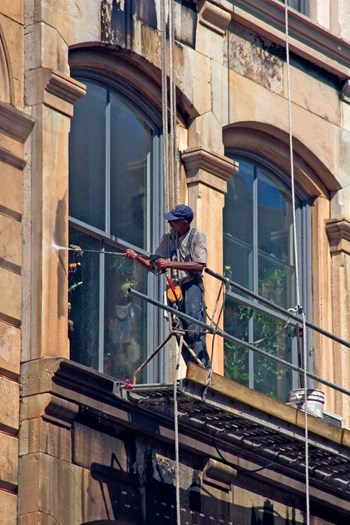
New York City’s co-ops and condos might vary in their architectural styles, but over time every exterior—from the ornate historic landmark to modern glass-and-steel fishbowl—experiences exterior wear due to the elements and the simple passage of time. As years go by, most facades and exterior surfaces will begin to lose their luster, and require occasional deep-cleanings, with regular maintenance to keep things looking good in between.
Buildings get dirty due to a number of factors, chief among them smog, dust, car exhaust, graffiti, exposure to the elements and even jet fuel. Cleaning them demands not only a thorough understanding of the accumulated crud itself, but also an arsenal of tools, products, and methods of getting back down to the gleaming clean surface underneath.
Culprits
“Exhaust causes a serious problem and creates a layer of soot,” says Ed Talmo, president of Graffiti Control Specialists/Enviro-Northeast in Highland Lakes, New Jersey. “Jet fuel can even be a problem if you’re near an area where there’s an airport.”
Carbon is the major contributing factor on most dirty urban buildings.
“Carbon and everything from smog and dust affect exteriors,” says Raymond G. Saleeby, president and CEO of Remco Maintenance, LLC in Long Island City. “It’s worse on the lower levels of a building than the higher levels because carbon is heavier than air. Also, rain patterns can create stains you would prefer not to have. Sometimes, stains are not uniform because of rain patterns and the way the drainage system works around the building.” And that creates unsightly smears and streaks on everything from glass to vintage terracotta.
Addressing Graffiti
Though overall the amount of graffiti in the city has declined significantly in the last decade or so, it still presents a problem that can be difficult to address—and nearly impossible to clean off certain surfaces.
“Graffiti itself is a serious problem,” says Talmo. “It affects property values and the look of the building. We did the Audubon Building on Broadway and East 4th, and it was extremely difficult to do. It took weeks of trying to find out which products worked and which ones didn’t.”
While harsh chemicals were once the gold standard when it came to stripping vandals’ paint off building exteriors, over the years products have become gentler and more environmentally-friendly.
“Years back when we first started doing graffiti removal, there were nasty chemicals like potassium hydroxide and metholine chloride,” says Talmo. “Now you have products that are a lot more environmentally-friendly and easier to use.”
Simply painting over graffiti might seem like a quick and easy solution, but that approach to the problem is not advised for several reasons.
“Putting paint on masonry is the worst thing you can do,” warns Talmo. “You’ll trap moisture, and if it freezes it will break the capillaries and the mortar, and the brick will be shot. At that point, you’d have to strip everything, let it dry out and seal it. That’s a major concern because that trapped moisture will deteriorate [the surface] to the point where it becomes a structural problem.”
In addition, some graffiti-marred surfaces are easier to clean than others. “You have to know what substrate that it was applied to,” says Wayne Bellet, president of Bellet Construction Co., Inc., in Manhattan’s Greenwich Village. “If it was porous, as in the case of polished marble vs. red brick, you’ll have trouble, because when you remove [the graffiti], you’ll have a scar against a weathered remain.”
There are preventative measures to keep your building from being affected by graffiti, both before you’re hit with it and after you’ve had a vandalized surface cleaned.
“For graffiti, you’ll want to apply a coating of graffiti barrier, which is a breathable product,” says Talmo. “If you do apply a graffiti barrier system, your building’s in-house staff can easily take care of removing graffiti.”
Graffiti barrier products also offer another incentive, in addition to providing an easy-to-clean surface. As opposed to just painting over graffiti, a truly clean surface will discourage the vandals from coming back and re-spraying your building.
“Painting over graffiti is just cleaning the blackboard, and they’ll come back and [spray graffiti] again. If they see a masonry surface that’s been cleaned, they’ll lose heart, go somewhere else,” says Talmo.
Regular Maintenance and Cleaning
Dirt and graffiti not only look terrible but they can also present problems for your building that go beyond aesthetics.
“As dirt builds up, it will draw in even more moisture and after a while it gets extremely difficult to remove,” says Talmo. “The sooner you remove it, the better off you are.”
Cleaning costs can vary greatly, depending on the size of your building, the type of work being done and the material being cleaned, among other factors. It’s wise to get several quotes from reputable exterior maintenance companies before hiring a firm to do work on your co-op or condo’s facade.
“We always quote a specific job depending on the types of products, the types of scaffolding needed, and the various permits involved,” says Talmo. “Cost is a wide open spectrum. You have to get several quotes, and have them in writing. Make sure the company you select has been in business for quite a while, has insurance in place and that they take responsibility for permits,” says Talmo.
As Saleeby notes, normally 15 percent of a co-op or condo’s operating budget is devoted to building maintenance—and exterior maintenance should be factored in accordingly.
“It depends on what the building is made of, the size of the building and other issues,” he says. “Is it a landmark building? Are we doing repairs? And so on. Normally, if we’re cleaning a regular eight-floor stone building, the cost might be $100,000 and probably take about four weeks to do.”
“Normal metal maintenance can cost anywhere from $600 a month to $8,000 a month depending on the size of the building,” says Saleeby.
A co-op or condo’s in-house staff can do some exterior cleaning themselves. However, when extensive cleaning or chemicals are required, it’s best to call in the professionals.
“Building staff can use water on metal periodically, but if they start using more than just water they could damage the metal—especially if there’s lacquer on it,” says Saleeby. “If you use more than a damp rag on metal, you may end up breaking down the lacquer and require more refinishing.”
Keeping metal in good shape in the first place will help you avoid eventual longer-term, costly repairs in the future.
“Maintaining metal on building is not expensive,” says Saleeby, “but refinishing is. If you maintain incorrectly, you’re going to double your refinishing costs. You want to try to avoid having to refinish. A professional will allow your refinishing to last longer.”
Tricks of the Trade
Although the professionals won’t always reveal their trade secrets, there are certain methods and product lines the professionals swear by.
“We use a process of cerium oxide to carefully polish glass and bring the weathered and aged look back to its original luster,” says Saleeby.
Talmo recommends Dumond Chemical for its product line and support staff.
“I favor the Cathedral Stone product cleaning line,” says Bellet. “They make a lot of lines, but their cleaning division is exemplary, along with Detrick and Prosoco, which makes a product line called Sure Klean. Peel-a-way is also good.”
“Within those companies and their lines there are different gradations of cleaners,” Bellet continues. “One has more alkaline and one has more stripping power. It used to be we had to spend enormous efforts in money and time to protect glass and metal surfaces from being etched [by harsh cleaning chemicals.] That’s what happened if you didn’t put on what was called an ‘acid stop,’ which would run out on to the street, into the sewers, and so on. Now we have strippable masking, which is a gelatinous compound that you roll out onto the glass. It turns into a rubbery surface that is either opaque or clear. You just do your cleaning and when you’re done, you pull it off and throw it away,” says Bellet.
Environmentally-friendly cleaners have an obvious advantage, in that they do not pollute or harm people or the environment around the building.
How the Pros Clean
Glass, metal and stone surfaces are all handled differently with regard to cleaning methods.
“We clean exteriors very carefully and use a series of methods, all in strict compliance with the material manufacturer’s designated instructions,” says Bellet. “Porosity is the biggest difference between cleaning surfaces. I ask, ‘What am I removing and what am I removing it from?’ We will only use materials that have been around for many trial and errors. I have to make sure it’s been tried and tested by other contractors and not me. I won’t use something new because I don’t want to chance something that’s irreversible,” says Bellet.
The water drip method is one that is often used on surfaces like limestone.
“This is a continuous flow of water for a period of time on stone to remove the dirt and carbon buildup. It works from top to bottom of the buildings and is very environmentally-friendly,” says Saleeby. “And we also use a Joss machine, which uses little glass pellets to impinge on stone to lighten it.”
Power washing is also commonly used to clean exteriors. Again, this method is best left to the experts.
“Power washers must be used by someone who is familiar with them,” cautions Talmo. “Otherwise you can do even more damage to the building.”
And it might sound like something out of a science fiction movie, but even dry ice can be used in exterior cleaning.
“We have a patented method of using dry ice,” says Bellet. “There is no detergent needed. The Landmarks [Preservation] Commission is just now reviewing it for approval.”
An exterior cleaning project can be done in stages, depending on the type of exterior material and the extent of dirt on or damage to the building’s surface.
“In terms of metal it’s a continuous maintenance program. Glass should be done once every 10 years. You can use protective coatings and sealers for unfinished and non-painted metals every six to 10 years. Stone should be cleaned every 15 years. The value of a building really comes out when you clean the stone. Respraying metallic coating on buildings that have painted surfaces should be done every 15 to 20 years,” says Saleeby.
“If you don’t have a maintenance program for metal, a periodic refinishing, just by age you could damage metal and have to refinish it,” says Saleeby. “Metal typically requires a monthly maintenance period. And annually or twice a year you’ll need to take the lacquer off metal and refinish it. I see buildings in New York City and the facades haven’t been addressed in decades, and eventually the metal will corrode if it is not addressed.”
Clean Up!
Regardless of the type of building you call home, a well-kept, routinely maintained exterior can have a noticeable impact on the look of your co-op or condo. According to Saleeby, a deep cleaning can really transform a building. “The difference is dramatic,” he says. “It really increases the value of the building significantly.”
And that says nothing of the benefits it provides to the structural integrity. It’s true that most internal building problems originate from within the walls, but with a solid exterior cleaning program in place, you can worry a little less about problems that Mother Nature can throw at you and your own little castle.
Stephanie Mannino is a freelance writer and a frequent contributor to The Cooperator.



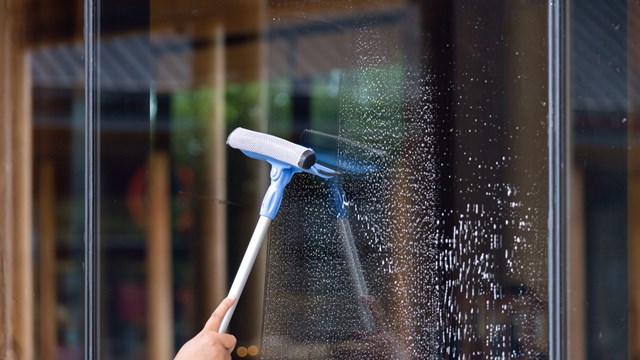
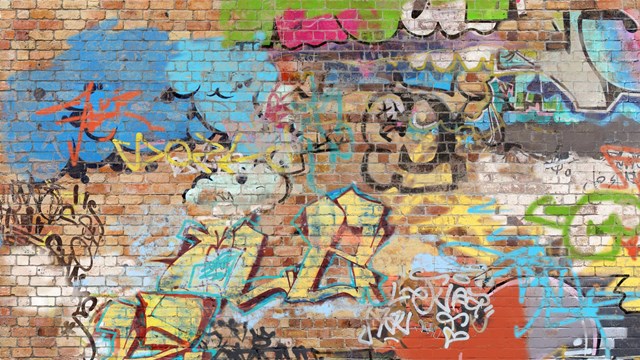
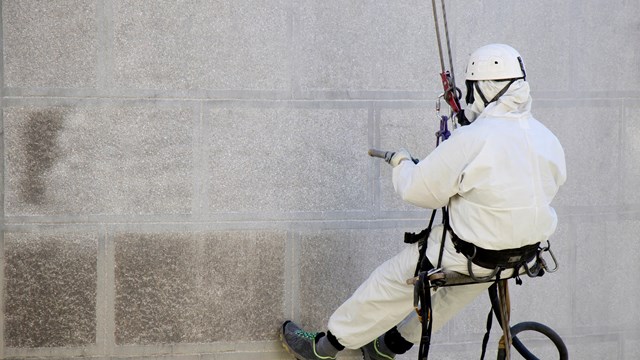


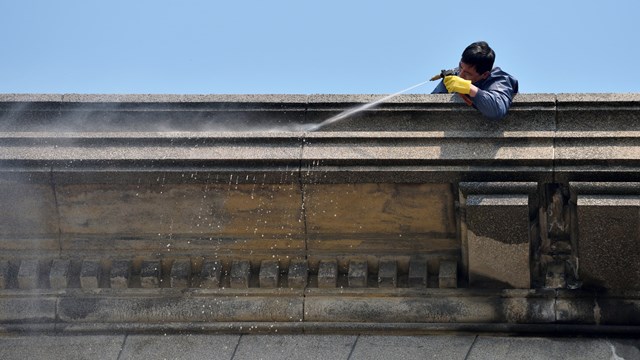
Comments
Leave a Comment